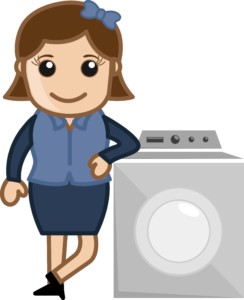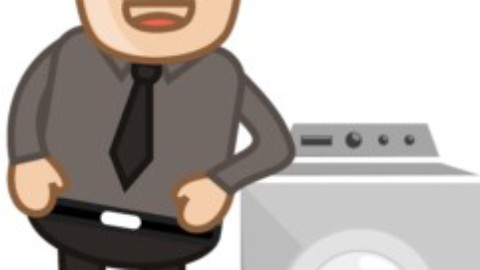Appliance Parts and Appliance Tips – Front Load vs. Top Load
 The biggest trend in washers today is the front-load machine (also known as H-axis). These washers open from the front, like a commercial washer in a Laundromat. In contrast, a traditional washer (V-axis) opens from the top. How to buy the best washer depends on your space and needs.
The biggest trend in washers today is the front-load machine (also known as H-axis). These washers open from the front, like a commercial washer in a Laundromat. In contrast, a traditional washer (V-axis) opens from the top. How to buy the best washer depends on your space and needs.
For buying a clothes washer, keep in mind each type has specific features:
Front Load:
- Can be stacked with a dryer on top to conserve space.
- Spins clothes faster than a top-load, extracting more water. This saves energy (and money), because it allows you to dry a load of clothes in a shorter amount of time.
- Uses a wash process that is more gentle on clothing.
- Requires a special type of detergent made for front-load machines. These detergents are becoming more common on grocery store shelves, but they might not be available everywhere. They also might cost a little more.
- Costs more. Prices vary, but expect to pay 30 percent to 40 percent more for a front-load machine than you would for a comparable top-load machine.
- Uses less water, which lowers utility bills. This savings can offset the additional cost of the machine, but it usually takes several years for the numbers to balance.
Top Load:
- Includes a wider variety of available models, colors and features.
- Costs less initially, but is less energy-efficient.
- Offers easier access to the wash tub.
- Uses regular detergent.
- Cannot easily be stacked to save space.
- Features to Consider
Your decision probably will be based on specific features that you want in a clothes washer. Different manufacturers use varying names for the same features, so do your research thoroughly. Here are a few things to look for in a washer:
Capacity: Since manufacturers define capacity differently, one “extra large” washer may not be the same as another. When comparing capacity, use the cubic foot measurement to make comparisons.
If your space is limited, you might want to look for a stackable washer-dryer unit. These are available either full-sized — with a front-load washer — or in smaller, apartment-sized sets.
Match the capacity of your washer to your dryer. You will defeat the purpose of increased efficiency if you have a super-sized washer but a dryer that will hold only half the load.
Like most large appliances today, a washer will last for years, so plan for the future and consider possible changes in your family size.
Tub material: Some tubs are made of porcelain-coated steel, which can deteriorate if the porcelain chips. In higher-end models, look for a plastic tub that will last the life of the machine. The best models have stainless steel tubs.
Water levels: The most efficient wash uses only enough water to cover the clothes. A washer with several water level settings allows you to use small amounts of water for small loads of clothes.
Cycles: Many models include permanent press, delicate and extra soak or extra rinse cycles. Look for a model with options that will give your clothes the care they need.
Different wash/spin speed combinations allow you to wash more types of clothing in ways that are safest for the fabric.
Water temperature: Using the correct water temperature will make your garments look better and last longer. Detergents, bleaches and fabric softeners work best at specific temperatures. Many of today’s washers include several wash/rinse temperature options.
In situations where the water coming into the washer is particularly cold, automatic temperature regulators make sure the wash water stays at a constant, correct temperature. For example, the standard hot/cold mix that a washer uses to create “warm” water might not give warm enough results if it is winter in Minnesota and the water coming from the cold pipe is frigid. Temperature regulators add different amounts of hot water as needed to make sure “warm” is the correct temperature.
If you will be washing items that require sanitizing, look for a model that offers a temperature boost function. Even an all-hot wash from a regular home hot-water heater might not reach a high enough temperature to kill germs.
Noise level: If your washer will be in or near a living area, the noise the unit makes will be a consideration. Some newer models offer additional insulation and reinforced frames to reduce operating noise.
Safety: Front-load machines include an automatic lock function that prevents the door from opening while the drum is spinning. The same feature is available on certain top-load models.
Controls: Washing machine controls have become more sophisticated and generally easier to use. Digital displays and one-touch selection can be programmed and preset to meet your washing needs. For a simpler wash process, choose a machine with dial and/or push-button controls.
Bleach and fabric softener dispensers: The chemicals (detergent, bleach, fabric softener) you use are a key part of garment care. Dispensers will automatically disperse them at the correct time.
Energy Star rating: The Energy Star label — conferred by the U.S. Department of Energy and the Environmental Protection Agency — indicates that a washing machine uses 35 percent to 50 percent less water and 50 percent less energy than a non-labeled machine. That makes the machine better for the environment and better for your wallet.








